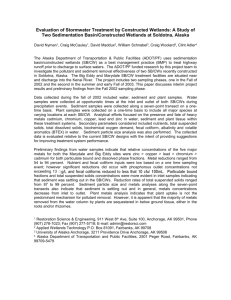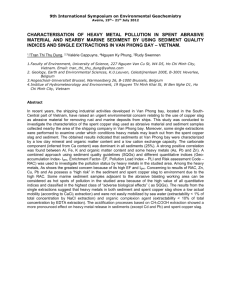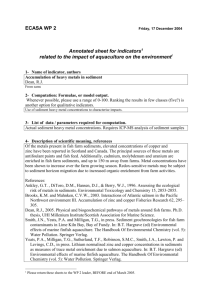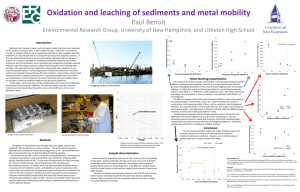The paper deals with the characterization of the sediments
advertisement
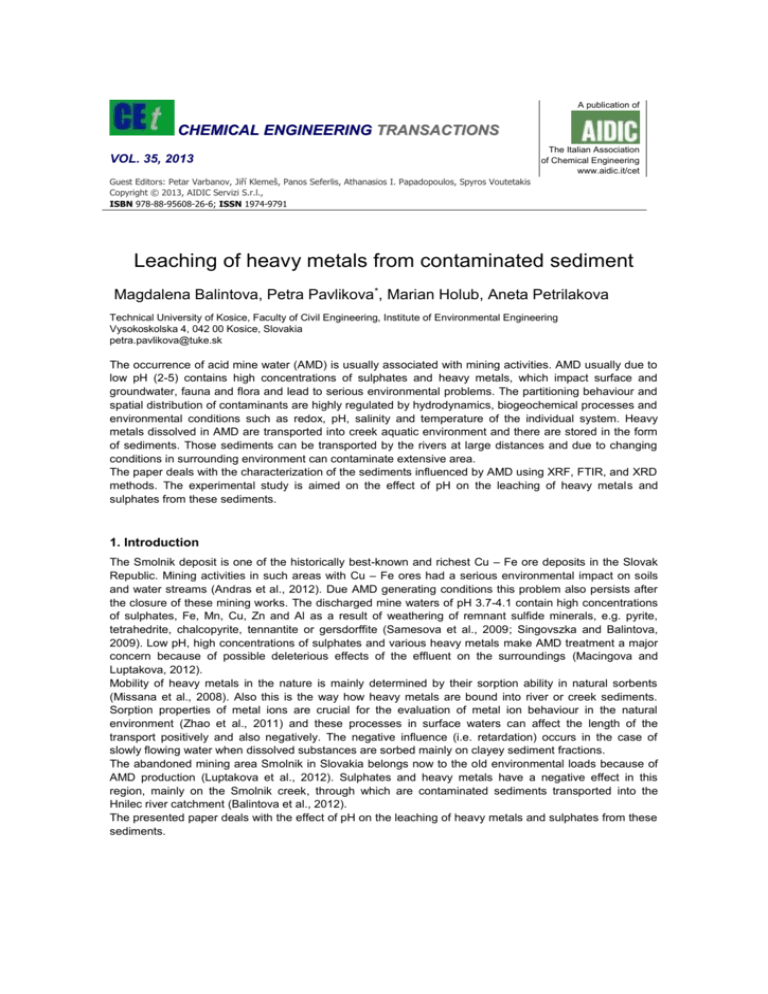
A publication of CHEMICAL ENGINEERING TRANSACTIONS VOL. 35, 2013 The Italian Association of Chemical Engineering www.aidic.it/cet Guest Editors: Petar Varbanov, Jiří Klemeš, Panos Seferlis, Athanasios I. Papadopoulos, Spyros Voutetakis Copyright © 2013, AIDIC Servizi S.r.l., ISBN 978-88-95608-26-6; ISSN 1974-9791 Leaching of heavy metals from contaminated sediment Magdalena Balintova, Petra Pavlikova*, Marian Holub, Aneta Petrilakova Technical University of Kosice, Faculty of Civil Engineering, Institute of Environmental Engineering Vysokoskolska 4, 042 00 Kosice, Slovakia petra.pavlikova@tuke.sk The occurrence of acid mine water (AMD) is usually associated with mining activities. AMD usually due to low pH (2-5) contains high concentrations of sulphates and heavy metals, which impact surface and groundwater, fauna and flora and lead to serious environmental problems. The partitioning behaviour and spatial distribution of contaminants are highly regulated by hydrodynamics, biogeochemical processes and environmental conditions such as redox, pH, salinity and temperature of the individual system. Heavy metals dissolved in AMD are transported into creek aquatic environment and there are stored in the form of sediments. Those sediments can be transported by the rivers at large distances and due to changing conditions in surrounding environment can contaminate extensive area. The paper deals with the characterization of the sediments influenced by AMD using XRF, FTIR, and XRD methods. The experimental study is aimed on the effect of pH on the leaching of heavy metals and sulphates from these sediments. 1. Introduction The Smolnik deposit is one of the historically best-known and richest Cu – Fe ore deposits in the Slovak Republic. Mining activities in such areas with Cu – Fe ores had a serious environmental impact on soils and water streams (Andras et al., 2012). Due AMD generating conditions this problem also persists after the closure of these mining works. The discharged mine waters of pH 3.7-4.1 contain high concentrations of sulphates, Fe, Mn, Cu, Zn and Al as a result of weathering of remnant sulfide minerals, e.g. pyrite, tetrahedrite, chalcopyrite, tennantite or gersdorffite (Samesova et al., 2009; Singovszka and Balintova, 2009). Low pH, high concentrations of sulphates and various heavy metals make AMD treatment a major concern because of possible deleterious effects of the effluent on the surroundings (Macingova and Luptakova, 2012). Mobility of heavy metals in the nature is mainly determined by their sorption ability in natural sorbents (Missana et al., 2008). Also this is the way how heavy metals are bound into river or creek sediments. Sorption properties of metal ions are crucial for the evaluation of metal ion behaviour in the natural environment (Zhao et al., 2011) and these processes in surface waters can affect the length of the transport positively and also negatively. The negative influence (i.e. retardation) occurs in the case of slowly flowing water when dissolved substances are sorbed mainly on clayey sediment fractions. The abandoned mining area Smolnik in Slovakia belongs now to the old environmental loads because of AMD production (Luptakova et al., 2012). Sulphates and heavy metals have a negative effect in this region, mainly on the Smolnik creek, through which are contaminated sediments transported into the Hnilec river catchment (Balintova et al., 2012). The presented paper deals with the effect of pH on the leaching of heavy metals and sulphates from these sediments. 2. Material and methods The sample no. 1 was taken from the tank where acid mine drainage directly flows out from old mining work through the shaft Pech. This water has a pH of 3 – 4 and directly influences the quality of the sediment. The second sample was taken from the Smolnik creek, which flows through the valley of the former mining area, approx. 200 m below the shaft Pech. The sediment samples were dried, homogenized, sieved through a 0.063 mm sieve and analyzed. The determination of chemical composition was realized by the XRF method using SPECTRO iQ II (Ametek, Germany). For this purpose the sediment samples were prepared as tablets with diameter of 32 mm by mixing of 5 g of sample and 1 g of dilution material (M-HWC) and pressed at pressure of 0.1 MPa/m2. Infrared spectroscopy with Fourier transformation (FTIR) was used for the sediments characterization in terms of functional groups qualitative analysis. FTIR measurements were performed using a Spectrometer Alpha-T (Bruker, Germany) with ATR module. Measurements carried out in transmittance mode, in the range 400 – 4000 cm-1 with resolution of 4 cm-1. The mineral composition was identified with diffractometer Bruker D2 Phaser (Bruker AXS, GmbH, Germany) in Bragg-Brentano geometry (configuration Theta-2Theta), using the 1.54060 Å CuKα radiation, Ni Kβ filters and scintillation detector at a voltage of 30 kV and10 mA current. Scan conditions were identical for all samples, recording times about 2 hours, a step size of 0.04° (2Θ) and step time of 3 s. The XRD patterns were processed using the software Diffrac.EVA v. 2.1. The ICDD PDF database (ICDD PDF – 2 Release 2009) was utilized for the phase identification. The first part of experiments was oriented towards the determination of the metal ions quantity released from the sediment after 24 hours. 5 g of each sediment sample (no. 1 and no. 2) was mixed with 200 ml of distilled water. The samples were filtered after 24 hours. The pH change was measured by pH meter inoLab 730(WTW, Germany) and the presence of Cu, Fe, Zn, Mn, Al and SO42- was determined by colorimeter DR890 (HACH LANGE, Germany). The second and third experiments were oriented to determination of the effect of pH on the redistribution of metals in sediment-water system. In the second experiment 5 g of sediment sample no. 2 was mixed with the solution of H2SO4 with defined pH (3.5 – 6.0). The samples were filtered after 24 hours. In the third experiment 5 g of sediment sample no. 2 was mixed with 200 mL of distilled water and pH of each suspension was adjusted to the required value (4.4 – 6.0) by adding of H2SO4 solution (pH=4.2). After stabilization of pH, the suspensions were filtered and the quantity of released metal ions was determined. All experiments were performed at laboratory conditions. 3. Results and discussion 3.1 Physical – chemical characterization of sediments In Table 1 concentrations of heavy metals and sulphates in the samples of sediments from shaft Pech and Smolnik creek by XRF analysis are presented. The measured results show that the concentrations of heavy metals and sulphates (e.g., SO 42-, Fe, As, Pb) are several times higher in the sediment sample no.1 as in the sediment sample no.2. This fact is caused by the acid mine drainage effluent from the shaft Pech, which affects the quality of sediments. Table 1: Results of chemical analyses of sediments by XRF method Parameter SO42Na K Ca Mg Fe Mn Al Si Cu Zn As Pb Unit [%] [%] [%] [%] [%] [%] [%] [%] [%] [%] [%] [%] [%] Sample no. 1 10.9 <0.2 0.63 0.12 0.44 33.0 0.02 2.37 2.54 0.0756 0.0128 0.1975 0.1081 Sample no. 2 0.36 1.0 2.01 0.27 0.80 5.42 0.06 6.54 17.48 0.0363 0.0191 0.0092 0.0110 The infrared spectrum of sample no. 1 confirmed presence of schwertmannite (Bigham et al., 1994) which is dominated by a broad, OH-stretching band centered at 3100 cm-1 (Figure 2). Another prominent absorption feature related to H2O deformation is expressed at 1634 cm-1. Intense bands at 1124, and 1038 cm-1 reflect a strong splitting of the 3(SO4) fundamental due to the formation of a bidentate bridging complex between SO4 and Fe. This complex may result from the replacement of OH groups by SO 4 at the mineral surface through ligand exchange or by the formation of linkages within the structure during nucleation and subsequent growth of the crystal. Related features due to the presence of structural SO 4 include bands at 981 and 602 cm-1 that can be assigned to 1(SO4) and 4(SO4), respectively. Vibrations at 753 and 424 cm-1 are attributed to Fe-O stretch; however, assignment of the former is tentative because similar bands in the iron oxyhydroxides usually occur at lower frequencies. A broad absorption shoulder in the 800 to 880 cm-1 range is apparent in some specimens and is related to OH deformation ((OH)) (Pacakova et al., 2000). This results are in accordance with work (Pallova et al., 2010) where was determined the presence of Fe16O16(SO4)3(OH)10.10H2O by XRD method in sediment from AMD Smolnik. FTIR spectrum of sample no. 2 showed different features (Figure 3). Based on the concentration of silicon in Table 1 and data from the literature (Guihua et al., 1998), it can be said that the main part of compounds are silicates including quartz (982, 825, 753, 695, 518 cm -1), but hydroxides (3600-3650 cm-1; 1652 cm -1) are present, too. Figure 2: FTIR spectrum of sediment no. 1 Figure 3: FTIR spectrum of sediment no. 2 The XRD patterns of sediments no. 1 and no. 2 are shown together in Figure 4. The spectrum of sediment no. 1 points to a small part of crystalline phase, it contains only three weak peaks of clinochlore and one peak of quartz. According to the literature (Lintnerova, 1996) AMD precipitates from shaft Pech contains minerals such as ferrihydrite, goethite, jarosite or schwertmannite. Fresh precipitates are weakly crystallized, formed crystals are very small (tens to hundreds of nm), which is typical for all studied precipitates. Due to their weak crystallinity, it is hard to identify only by X-ray diffractometry (XRD) (Bigham, 1994). In sediment sample no.2 was identified phases: Q – quartz SiO2 (PDF 01 – 075 – 8322), M – muscovite 2M1, ferrian K Al1.65 Fe0.35 Mn0.02 (Al0.7 Si3.3 O10) (OH) 1.78 F0.22 (PDF 01 – 073 – 9857), and C – clinochlore 1MIIb, ferroan (Mg, Fe)6 (Si, Al)4O10 (OH)8 (PDF 00 – 029 – 0701). The most dominant component is quartz with 6 broad peaks (the strongest line at 26.623° 2Θ). Figure 4: XRD patterns of sediments no. 1 and no. 2 (Identified compounds: Q – quartz; M – muscovite2M1, ferrian; C – clinochlore1MIIb, ferroan) 3.2 Study of pH influence on leaching of metals from sediments The first experiment was aimed to leaching of metals and sulphates from sediment samples in distilled water. It was determined, that samples of sediments decreased pH values in leachates. The measured pH values of the leachates and distilled water are shown in Table 2. The table clearly shows that the sediment leachate no.1 has value of pH more than half lower as the sediment leachate no.2. Table 2: The measured pH values of leachate samples and distilled water pH 7.07 2.85 6.14 Distilled water Sample no.1 Sample no.2 Temp [°C] 24.7 25.2 25.1 The determined concentrations of heavy metals and sulphate in the leachates of samples no. 1 and no. 2 In are shown in Table 3 (measured in mg/L and also percentage of leachate of corresponding component). Table 3: Concentrations of heavy metals and sulphate in leachate samples Heavy metals Sample Cu Fe [mg/L] [%] [mg/L] No.1 No.2 Zn [%] [mg/L] Mn [%] [mg/L] [%] [mg/L] 1.83 9.68 4.90 0.06 0.02 0.625 0.02 0.22 0.04 0.003 <0.02 - 1.5 0.8 Sulphates Al 30 5.3 0.23 0.25 [%] [mg/L] [%] 0.04 0.015 130 26 4.7 28.8 Results of the experiment show that the content of heavy metals in sediment leachate no. 1 is higher than in sediment leachate no. 2. Manganese is the most released metal from the sediment to leachate. The second experiment was oriented on the influence of acidic solution with initial pH in range of 3.5-6 on leaching of metals only from sediment no. 2, which is typical sediment from the water flow. The initial and the final (after 24 hours) values of the pH of the leachates and the measured concentrations of heavy metals in leachate (measured in mg/L and also percentage of leachate in appropriate sample) are presented in the Table 4. Table 4: The concentrations of heavy metals in leachate with the pH in the range 3.5 – 6.0 Heavy metals pH 3.5 4.0 4.5 5.0 5.5 6.0 Cu [mg/L] 0.03 0.01 0.07 0.03 0.05 0.02 [%] 0.33 0.11 0.77 0.33 0.55 0.22 Fe [mg/L] [%] 0.05 0.003 0.5 0.03 0.36 0.26 0.48 0.03 0.39 0.028 0.30 0.022 Zn Al Final pH [mg/L] [%] 0.032 0.002 <0.005 0.011 0.0006 0.006 0.0003 <0.005 0.015 0.0009 6.990 7.090 7.151 7.188 7.311 7.275 Mn [mg/L] [%] [mg/L] <0.02 0.4 <0.02 0.5 <0.02 0.5 <0.02 0.4 <0.02 0.3 <0.02 0.4 [%] 2.66 3.3 3.3 2.66 2 2.6 As it is seen from Table 4 there was difficult to find a relationship between the determined concentration of heavy metals and the different values of pH, because final pH of the leachates after 24 hour experiment was in the range of 6.99 – 7.26 pH. It can be explained as an influence of the buffering ability of sediment. In Table 5 are presented the determined concentrations of heavy metals in leachate at the appropriate pH of the third experiment. Their graphical presentation is presented in Figure 5. Table 5: Concentrations of heavy metals in leachate at the appropriate pH Heavy metals pH 4.4 4.7 4.8 5.3 6.0 Cu [mg/L] 0.10 0.05 0.05 0.04 0.03 [%] 1.1 0.55 0.55 0.44 0.33 Fe [mg/L] 0.49 0.48 0.34 0.04 0.03 [%] 0.02 0.04 0.036 0.003 0.002 Zn [mg/L] <0.02 <0.02 <0.02 <0.02 <0.02 Mn [%] [mg/L] [%] 1.6 10.67 0.42 1.3 8.67 0.42 1.1 7.34 0.9 6 0.42 0.2 0.33 Al [mg/L] 0.125 0.088 0.059 0.045 0.062 [%] 0.007 0.005 0.004 0.003 0.004 Figure 5: Presentation of the heavy metals release at the different pH value The results confirm the literary data (Petersen et al., 1997; Simpson et al., 1998) that the content of heavy metals in leachates is increased by reduction of the pH. The best leaching element was manganese (10.67 % at pH 4.4). 4. Conclusions Sediment disturbance can lead to changes in the chemical properties of sediment that stimulate the mobilisation of contaminants. Published data are focused on the release of contaminants from sediment into distilled water or solution of sulphuric acid with various values of pH. Research shows that changes in pH can accelerate desorption and partitioning of contaminants in sediment influenced by acid mine drainage. Decreasing of pH can increase the solubility of metals in sediment and increasing of the toxic metals concentration in water environment. Acknowledgements This work has been supported by the Slovak Research and Development Agency under the contract No. APVV-0252-10 and by the Slovak Grant Agency for Science (Grant No. 1/0882/11) References Andras P., Turisova I., Marino A. and Buccheri G., 2012, Environmental hazards associated with heavy metals at Lubietova Cu-deposit (Slovakia), Chemical Engineering Transactions, 28, 259 – 264, DOI: 10.3303/CET1228044. Balintova M., Petrilakova A., Singovszka E., 2012, Study of Metals Distribution between Water and Sediment in the Smolnik Creek (Slovakia) Contaminated by Acid Mine Drainage, Chemical Engineering Transactions, 28, 73-78, DOI: 10.3303/CET1228013. Bigham, J. M., 1994, Mineralogy of ochre deposits formed by sulfide oxidation., The environmental geochemistry of sulfide mineral-wastes, Mineral. Assoc. Canada 22 , Waterloo, 103-132. Bigham J. M., Carlson L., Murad E., 1994, Schwertmannite, a new iron oxyhydroxysulphate from Pyhasalmi, Finland, and other localities, Mineralogical Magazine, 58, 641-8. Guihua L., Xiaobin L., Chuanfu Z., Zhihong P., 1998, Formation and solubility of potassium aluminosilicate, Transactions of Nonferrous Metals Society of China, 8, 120-2. Lintnerova, O., 1996, Mineralogy of Fe-ohre deposits formed from acid mine water in the Smolnik mine (Slovakia), Geologica Carpathica Clays, 5, 55-63. Luptakova A., Prascakova M. and Kotulicova I., 2012, Occurrence of acidithiobacillus ferrooxidans bacteria in sulfide mineral deposits of Slovak Republic, Chemical Engineering Transactions, 28, 31 – 36, DOI: 10.3303/CET1228006. Luptakova A., Macingova E., Apiariova K., 2008, The Selective Precipitation of Metals by Bacterially Produced Hydrogen Sulphide, Acta Metallurgica Slovaca, Special issue 1, 149 - 154. Macingova E., Luptakova A., 2012, Recovery of Metals from Acid Mine Drainage, Chemical engineering Transactions, 28, 109-114, DOI: 10.3303/CET1228019. Missana T., Garcia-Guttierez M., Alonso U., 2008, Sorption of strontium onto illite/smectite mixed clays, Physics and Chemistry of the Earth, Elsevier, Vol. 33, No. 1, 156-162. Pacakova V., Poskeviciute D., Armalis S., Stulik K., Li J., Vesely J., 2000, A study ofdistribution of lead, cadmium and copper between water and kaolin, bentonite and river sediment., Journal of Environmental Monitoring, 2, 187-91. Pallova Z., Kupka D., Achimovicova M., 2010, Metal mobilization from AMD sediments in connection with bacterial iron reduction, Mineralia Slovaca, 42, 343-7. Petersen W., Willer E., Willamowski C., 1997, Remobilization of trace elements from polluted anoxic sediments after resuspension in oxic water, Water Air Soil Pollut, 99, 515– 522. Samesova D., Nagyova I., Melichova Z., Andras P. and Hybska H., 2009, Presence of heavy metals in waters of old mining area Lubietova, Studia Oecologica, 3, 84 – 88 Simpson S.L., Apte S.C., Bately G.E., 1998, Effect of short-term resuspension events on trace metal speciation in polluted anoxic sediments, Environ Sci Technol, 32, 620– 625. Singovszka E., Balintova M., 2009, Environmental risk assessment of the Smolnik creek contaminated by acid mine drainage, Selected Scientific Papers: Journal of Civil Engineering 2, 37-44. Zhao G., Wu X., Tan X., Wang X., 2011, Sorption of Heavy Metal Ions from Aqueous solutions: A Review, The Open Colloid Science Journal, 19-31.
